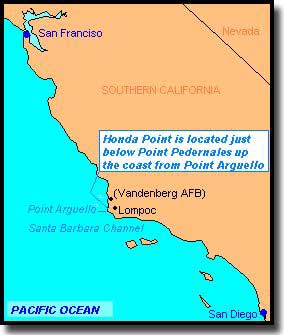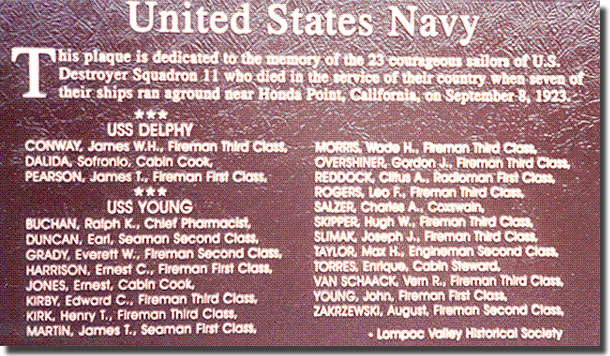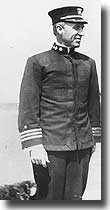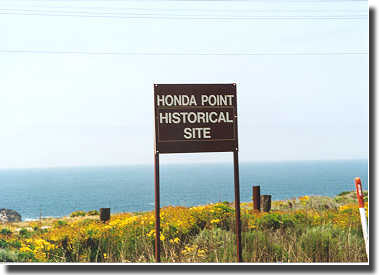Seven Clemson Class Destroyers all wrecked at Honda Point on the 8th. of September 1923
Introduction.
In the worst peacetime disaster in the history of the United States Navy, on the evening of the 8th. of September 1923, 14 Destroyers from Squadron Eleven, led by Captain Edward Watson USN, were making for San Diego from San Fransisco. At 2100, believing they were steaming east into Santa Barbara Channel, the flagship led his Squadron at 20 knots slap bang into the rocks and shoreline at Honda Point.
Seven of his ships were wrecked, and 23 sailors died.

An aerial shot of the disaster, taken on the 13th. of September 1923.
The seven destroyers who came to grief on the rocks at Honda Point are noted.
San Fransisco to San Diego.
Captain Edward Watson USN, in his flagship, the destroyer USS Delphy, led his other 13 DD's out of San Fransisco bay, in the following order, and turned south, for the12 hour run down the Californian coast to San Diago, and ordered a speed of 20 knots.
|
Destroyer
|
Squadron Commander
|
Division Commander
|
Commanding Officer
|
Others
|
|
Delphy
DD #261
|
Capt Edward H. Watson
|
|
LCdr Donald T. Hunter
|
Navg. Ltjg Lawrence F. Blodgett
|
|
S.P. Lee
DD #310
|
|
#33 Capt Robert Morris
|
Cmdr William H. Toaz
|
|
|
Young
DD #312
|
|
|
Cmdr William L. Calhoun
|
|
|
Woodbury
DD #309
|
|
|
Cmdr Louis P. Davis
|
|
|
Nicholas
DD #311
|
|
|
LCdr Herbert O. Roesch
|
|
|
Farragut
DD #300
|
|
#31 Cmdr William S. Pye
|
LCdr John F. McClain
|
|
|
Fuller
DD #297
|
|
|
LCdr Walter D. Seed
|
|
|
Percival
DD #298
|
|
|
LCdr Calvin H. Cobb
|
|
|
Somers
DD #301
|
|
|
Cmdr William P. Gaddis
|
|
|
Chauncey
DD #296
|
|
|
LCdr Richard H. Booth
|
|
|
Kennedy
DD #306
|
|
#32 Cmdr Walter G. Roper
|
LCdr Robert E. Bell
|
|
|
Paul Hamilton
DD #307
|
|
|
LCdr Tracy L. McCauley
|
|
|
Stoddert
DD #302
|
|
|
LCdr Leslie E. Bratton
|
|
|
Thompson
DD #305
|
|
|
LCdr. Thomas A. Symington
|
|
12 Hours later.
The Squadron formed up in column formation astern of the leader Delphy, steaming at 20 knots, the course south. Poor visibility meant the Squadron navigators had to rely only on Dead Reckoning, at the speed ordered, depth sounding could not be taken.
When the ships were due to alter course to the east into the Santa Barbara Channel, the radio direction finding ( RDF ) equipment stationed at Point Arguello ( a few miles South of Point Honda ) indicated that the Squadron of Destroyers was , in fact, still to the North of the Channel. But, this warning was not accepted, RDF being in its infancy was discounted. The 14 ships sped on oblivious to any impending danger.
It is note worthy that the Squadron Commander did not take the prudent action of ordering his ships to slow down to allow the depth of water under his Squadron to be measured by the depth sounding equipment that was available. Instead he trusted his own judgement and that of his specialist navigators, and ploughed on regardless of any risks

Map showing the location of Honda Point
It is now dark and quite dense fog came down.
By now darknes had fallen , and the ships ran into dense fog, one would have thought that fact would be enough to ring the warning bells for Captain Watson, but no, press on he did with 13 destroyers following in his wake, each in line behind the destroyer in front of them.

Wrecks of USS Detroyers Delphy, and Nicholas at Honda Point 1923
Running Aground.
Some bare five minutes after turning eastwards, Delphy ran SLAP BANG into the Honda shoreline, and stuck fast.
Next came USS Lee, on observing his leader suddenly stop, she turned to port, but too late, and came to grief North of Delphy.
Next in line, USS Young ran on rocks, ripping open her thin hull, and turning her onto her starboard side, just to the south of Delphy.
The following two ships in line, Woodbury and Nicholas turned to starboard and port respectively, but alas, both ships finished on the rocks.
Next came USS Farragut, one of the lucky ones, her Captain ordered his engines quickly to go astern, and so avoided any disaster.
Now Fuller came to grief near Woodbury.
Percival and Somers managed to escape the fate of their sister ships.
Chauncey trying to rescue men clinging onto the wreck of USS Young unfortunately went aground herself.
The final four ships out of the long line of 14 destroyers had time to avert any disaster, all were able to turn in time to clear the coastal rocks and shoreline.

The plaque to mark the death of 23 sailors in the Honda Point disaster
Court of Inquiry.
A Court of Inquiry was set up to investigate this mammoth disaster, the worst in the peacetime history of the USN, the loss of seven destroyers and the death of 23 sailors, 3 from the flagship USS Delphy and 20 from USS Young.
This Court recommended that 11 Officers be brought before Courts Martials, these were as follows:-
The Squadron Commander, Captain. Watson, in USS Delphy.
The Captain of USS Delphy, Lieutenant Commander Hunter.
The Navigating Officer of USS Delphy, Lieutenant Jg. Blodgett.
The Divisional Commander of DIV 33, in USS S P Lee, Captain Morris.
The Captain of USS S P Lee, Commander Toaz.
The Captain of USS Young, Commander Calhoun.
The Captain of USS Woodby, Commander Davis.
The Captain of USS Nicholas, Lieutenant Commander Roesch.
The Divisional Commander of Div 31, in USS Farragut, Commander Pye.
The Captain of USS Fuller, Lieutenant Commander Seed.
The Captain of USS Chauncey, Lieutenant Commander Booth.
Note, all of these 11, were United States Navy Officers.
Courts Martials ordered.
The 11 Officers listed above were brought before Courts Martial, and tried, four were found guilty; one of the four, the Commanding Officer of the USS Nicholas, had his conviction set aside by higher authority. The blame for the accident rested with the Squadron Commander (Capt. Watson), plus the Captain of the Delphy (LCdr. Hunter) and the Navigating Officer (Lt. Blodgett) of his flagship. The Squadron Commander was sentenced to lose one hundred fifty numbers on the list of Captains, and the Commanding Officer of his flagship one hundred numbers on the list of Lieutenant Commanders. Lieutenant Blodgett, the Navigating Officer in the Squadron Commander's Flagship USS Delphy,was acquittedby the Court, and found NOT GUILTY AS CHARGED.
These sentences were mild to say the least, given the extent of the grounding of seven destroyers and the loss of 23 lives, those involved were lucky to be treated so lightly. The JAG at the Inquiry and General Courts Martial, Lieutenant Commander Leslie Bratton, was transferred to Washington DC, and ordered to review the findings of the Court and report back to the Secretary of the Navy.
The Secretary of the Navy had not been pleased with the outcome of the Courts Martial.
The Secretary of the Navy was not happy with the findings of the Court, he had wanted heads to roll. The outcome of the review, was that all Officers acquitted by the Court Martial had their findings reversed, but no new trials were ordered.
But it all proved to be too late.
However, it all proved to be too late, the Secretary of the Navy was replaced in 1924, and this sorry chapter in the history of the United States Navy was finally closed.

Destroyer Squadron Eleven Commander,
Captain Edward Watson USN,
when he was a Commander
Conclusion.
This Class of Destroyer was similar to those involved in the deal done by F. D. Roosevelt with Winston Churchill when 50, 4 stack, flush deck Destroyers from WW1 swapped hands from the USN to the Royal Navy in WW2 in return for bases in the West Indies. Within a few weeks, the pounding the wrecks received from heavy seas rolling in to the Californian coast from the Western Pacific broke up the ship's hulls and scattered the pieces of steel along this rocky coastline.
I have observed before that any Captain of a Naval ship who puts his command at risk, and does not take prudent action such as slowing down to take soundings in this case, and then runs aground, is almost certain to pay the penalty at his subsequent Court Martial, ( although in this case, those arraigned before Courts Martial got off very lightly. )
So it happened in the case of these seven destroyers stranding at Honda Point on the 8th. of September in 1923. Any chance of further promotion of Captain Watson, who had won a Navy Cross in WW1, very unlikely. This area is now a part of Vandenberg Air Force Base.
Note of thanks.
I wish to sincerely thank Stanley Golowski, Captain USMC ( Ret.) for providing the table setting out the details of the 14 destroyers, and the photographs of the Memorial Plaque and the Marker for Honda Point. See Stanley's letter: "Point Honda Disaster in 1923 - General Courts Martial"
I also want to acknowledge his exhaustive research, and documentation of this Disaster at Honda Point, see for yourself at these two links:
Point Honda Memorial web site designed in honor of the 23 sailors who perished in an accident on Sept. 8, 1923, when seven U. S. Navy Destroyers attached to Destroyer Squadron Eleven were stranded at Point Honda, California

Marker depicting the Honda Point area
Point Honda Research subsite covers the naval shipwrecks which occurred at Point Honda, California—also known as Pedernales Point and La Honda, now Vandenberg Air Force Base—on September 8, 1923
MJG.

USS Nicholas aground at Honda Point 1923







